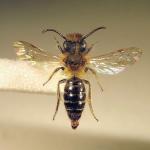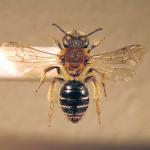This medium-sized Andrena is very similar to the common Andrena dorsata (Kirby), with bright foxy hairs on the thorax and a shining black abdomen with fine lines of white hairs on the apices of the segments, only even more contrasting in appearance. It may be confirmed by careful examination, looking at the shape and form of the hairs on the hind tibia in females and the presence of a line of black hairs against the eyes in the male. It is a rather enigmatic species, being very abundant in a locality for a number of years and then apparently disappearing. I have not seen it frequently since a period in the 1990s, when it occurred in many areas in West Sussex.
Until recently this species was misnamed A. congruens. According to Wood (Wood, BWARS Newsletter Autumn 2022) A. congruens has a northern range limit in central Germany and the name A. confinis should be used for the British fauna from now on.
Southern England, with rather more of a central distribution than many of the southerly species, which tend to be south-easterly, also recorded in south Wales.
It is widespread in Central Europe.
This species is listed in Falk (1991) as Nationally Notable/Na (now known as Nationally Scarce).
It occurs in a range of habitats with lighter soils; I have found it in sand and gravel pits as well as on the extensive chalk grasslands of Salisbury Plain.
Bivoltine: late March to May, and July to August.
A species which may nest in very large aggregations on patches of bare ground.
A very wide range, including hawthorn, sallow, blackthorn, dandelion, hogweed, and wild carrot.
None known.
2023



